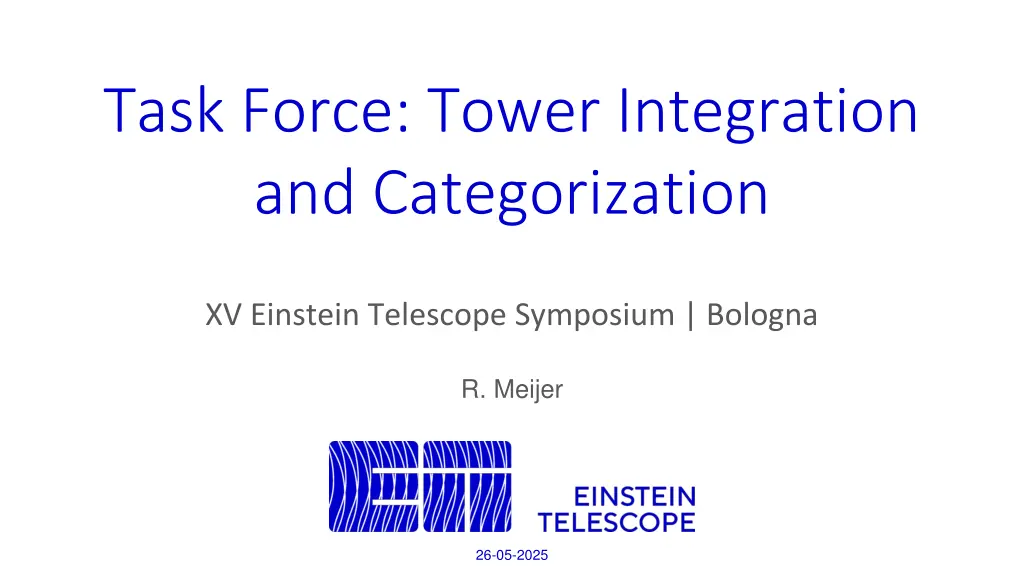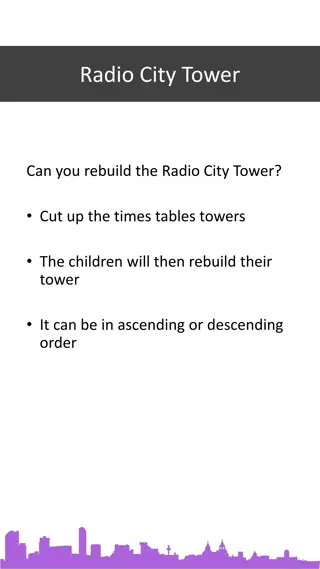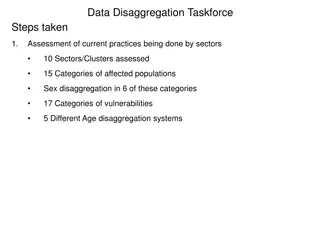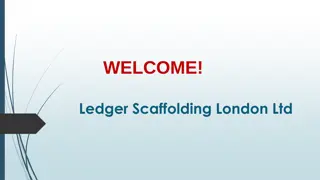
Tower Integration and Categorization at Einstein Telescope Symposium
Explore the integration and categorization of tower nodes at the Einstein Telescope Symposium, including specifications, scope extensions, and considerations for configuration changes. Discover the main considerations for configuration changes and the progression of tower categorization based on previous work.
Uploaded on | 2 Views
Download Presentation

Please find below an Image/Link to download the presentation.
The content on the website is provided AS IS for your information and personal use only. It may not be sold, licensed, or shared on other websites without obtaining consent from the author. If you encounter any issues during the download, it is possible that the publisher has removed the file from their server.
You are allowed to download the files provided on this website for personal or commercial use, subject to the condition that they are used lawfully. All files are the property of their respective owners.
The content on the website is provided AS IS for your information and personal use only. It may not be sold, licensed, or shared on other websites without obtaining consent from the author.
E N D
Presentation Transcript
Task Force: Tower Integration and Categorization XV Einstein Telescope Symposium | Bologna R. Meijer 26-05-2025
Context of Tower nodes Tower nodes are subsystems of ET s Low-Frequency and High-Frequency Interferometers (LFI, HFI) - Interfaces with Optical Layout: Residual Motion level and Payload boundary conditions (size, type, co-location) - Interfaces with Detector Layout: Accessibility constraints, allowable space claim - Considered are three subsystems: Optical payload, Seismic Isolation System, Vacuum Vessel b. Vacuum Vessel c. Seismic Isolation System (Detail view) a. Optical payload Sys. level 2: LF-Interferometer SYS_004 (LFI) Sys. level 3: LF-Test Mass tower SYS_129 (LITM_Y)
Capturing tower specifications Tower specifications are stored in Output Tables TAB2 (Triangle) and TAB7 (2L) 1. Specification line root 1c. Seismic Isolation subsystem specifications 1a. Optical Payload subsystem specifications 1b. Vacuum vessel subsystem specifications 1. SYS_129 (LITM_Y)
Scope of tower categorization exercise Tower categorization proceeds on previous work: ET-0577A-24 MEMO: Einstein Telescope Preliminary Suspension System Classification ET-0676A-24 Preliminary Detector Layout - 10km Triangle Notable scope extensions compared to previous work: Introduction of 6thSUS Residual Motion (RM) category Preliminary estimate of quantified RM levels for select nodes Increased maturity with Optical and Detector layout for tower boundary conditions (e.g. required bench footprint, co-location, accessibility constraints, ) Recategorization of Triangle and extension to 2L configuration Inclusion of Auxiliary optical benches both In-vacuum/Suspended and In-air/Non-suspended Some general remarks: Wherever available, flexibilities on boundary conditions are retained and highlighted alongside the baseline categorization Categorization is performed subsystem design-agnostic tower subsystem design space is retained as much as possible High-level conceptual design considerations conceived within the Task Force work are recorded in the Supporting Document Categorization almost equivalent between Triangle and 2L configurations exceptions in nodes HZM5_X/Y +1 additional node per corner for Triangle LF SQZ steering mirror (LSQ-ZM_A/B/C) Highly recommended to proceed future work with increased Tower subsystem integration activity 4
Main considerations for configuration changes Expected major impact on excavation volume 1) Reduction in height of the LF Test Mass Seismic Isolation System Large effect due to size of LF Cornerpoint Cavern 2) Reduction in height of HF non-Test mass nodes Long, tall caverns with many nodes 3) Reduction in footprint of Auxiliary benches AUX benches are many and widespread, premature footprint estimation from legacy work 4) Consistent application of lateral or bottom tower access Avoiding scattered bottom-access basements, avoiding lateral access wherever inconvenient 5) Accommodating a shift towards optical element co-location Co-locating optical elements in an increased # of nodes to reduce excavation cost resulting from optical layout Expected medium/small impact on excavation volume 6) Reduction of ET-LF Cryostat footprint Impact larger for Triangle configuration than 2L Dependent on LF Test Mass tower subsystem design maturity 7) Reduction of LF non-Test Mass tower height Proximity to taller LF-Test Mass tower in the same cavern 8) Reduction of HF Test Mass tower height Proximity to taller towers in the same cavern 5
Categorization update 1/5 large impacts 1) Reduction in height of the LF Test Mass Seismic Isolation System Reduction adopted from ongoing LF-TM integration and SUS LF-TM tower conceptual design exercises
Categorization update 2/5 large impacts 2) Reduction in height of HF non-Test mass nodes HF s more relaxed residual motion requirements can likely be satisfied by low (modular) SUS systems
Categorization update 3/5 large impacts 3) Reduction in footprint of Auxiliary benches Increased maturity of Optical AUX subsystem bench space requirements estimation Strategic grouping of AUX systems 9
Categorization update 4/5 large impacts 4) Consistent application of lateral or bottom tower access Default access: lateral Exceptions for LF-TM towers and HZM5_X/Y in 2L configuration Flexibility retained wherever possible (e.g. not possible in SQZ lab only lateral access option) 5) Accommodating a shift towards optical element co-location Emphasis on top-loaded bench Suspension architectures Design flexibility on conceptual suspension system solution retained 5) 4) 10
Categorization update 5/5 new introductions 6) 2x: Periscope tower (HF and LF) Introduced need by Optical layout: plane difference between SQZ lab and main ITF Maximum flexibility retained, new design effort required 7) 25x: Bookkeeping of In-air Non-suspended benches Previously uncategorized, but also require footprint No dedicated design effort envisaged for now 11
Tower subsystem design flexibility retained High-level Suspension System design considerations summarized per Residual Motion category in Supporting document 12
Tower subsystem design flexibility retained High-level Cryostat and Vacuum Vessel considerations also summarized in Supporting document 13
Summary Scope of exercise extended significantly over previous efforts Increased maturity for integration between tower nodes and external dependencies Updated tower categorization per ITF pair: 128 (129 Triangle) nodes spread over 13 types Configuration changes adopted that are expected to have major impacts on excavation volume New tower types introduced: HF and LF Periscopes and In-air Non-suspended AUX benches Approx. 100 out of 128 nodes captured as either In-air, CAT1 or CAT2 bench towers Boundary condition flexibility retained alongside baseline configuration Tower subsystem design flexibility retained, conceptual considerations documented 14






















